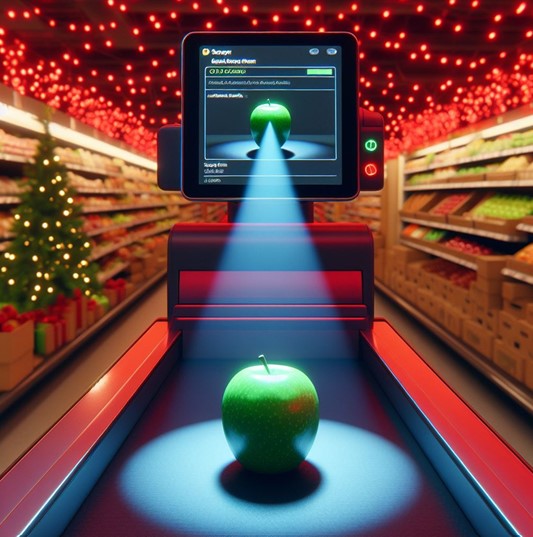Authors:
Bhavik Joshi
Abstract:
The proposed invention, the "Smart Adaptive Lighting Module," works by dynamically adjusting the lighting conditions under which produce is viewed by a recognition system. The goal is to provide consistent, optimal lighting that allows the system to accurately recognize different types of produce, regardless of the external lighting conditions.
Background:
The invention addresses the problem of variable and inconsistent lighting conditions in retail environments, which can significantly affect the performance of produce recognition systems. These systems typically rely on computer vision and machine learning algorithms to identify different types of produce, and changes in lighting can alter the appearance of the produce, making it harder for the system to accurately recognize them.
One known solution to this problem is to use a controlled lighting environment, such as a light box, to illuminate the produce. This ensures that the produce is always viewed under the same lighting conditions, regardless of the external lighting. However, this solution can be expensive and impractical to implement in a fast-paced retail environment. It also doesn't eliminate the influence of external lighting, especially in brightly lit stores.
Another solution is to train the recognition system on a diverse dataset that includes images of produce under a variety of lighting conditions. This can make the system more robust to changes in lighting. However, it can be challenging to collect a sufficiently diverse dataset, and even then, the system may still struggle with lighting conditions that were not included in the training data.
While the known solutions can mitigate the effects of variable lighting conditions to some extent, they are not completely effective and have significant drawbacks. A solution that can dynamically adjust to any lighting condition, like the proposed invention, could significantly improve the accuracy and robustness of produce recognition systems. The use of machine learning allows the system to learn from experience and continuously improve its performance over time, which is a significant advantage over static solutions.
Description:
The proposed invention, the "Smart Adaptive Lighting Module," works by dynamically adjusting the lighting conditions under which produce is viewed by a recognition system. The goal is to provide consistent, optimal lighting that allows the system to accurately recognize different types of produce, regardless of the external lighting conditions.
The core of this module would be a high-intensity, natural white light LED array that can dynamically adjust its intensity and color temperature based on the ambient lighting conditions. This would ensure that the produce is always illuminated with consistent, optimal lighting, regardless of the external environment.
The module will include a small sensor array to continuously monitor the ambient light conditions. This data would be fed into a machine learning algorithm that has been trained to determine the optimal LED settings for any given lighting condition.
The system will also include a feedback loop from the produce recognition system itself. If the recognition system is having difficulty identifying a particular item, it could signal the lighting module to adjust its settings, potentially improving the recognition accuracy.
Here's a step-by-step description of how the system could work:
Monitoring Ambient Light: The system includes a sensor array that continuously monitors the ambient light conditions. This could include measurements of light intensity, color temperature, and direction.
Processing Sensor Data: The sensor data is fed into a machine learning algorithm that has been trained to determine the optimal lighting settings for any given ambient light condition. This algorithm could be implemented using a variety of machine learning techniques, such as regression, decision trees, or neural networks.
Adjusting LED Settings: Based on the output of the machine learning algorithm, the system adjusts the settings of a high-intensity, natural white light LED array. This could include adjustments to the intensity and color temperature of the light.
Capturing Images: The produce is illuminated by the LED array and images are captured by the recognition system's camera. Because the lighting conditions are controlled by the LED array, the appearance of the produce in the images remains consistent, regardless of the external lighting conditions.
Recognizing Produce: The images are processed by the produce recognition system, which uses computer vision and machine learning algorithms to identify the type of produce.
Feedback Loop: If the recognition system has difficulty identifying a particular item, it can signal the lighting module to adjust its settings. The machine learning algorithm can also learn from these feedback signals, allowing it to improve its performance over time.
This system could be implemented using existing hardware components, such as LED arrays and light sensors, and software libraries for machine learning and image processing. It would require some modifications to the produce recognition system to integrate the lighting module and implement the feedback loop.
By providing consistent, optimal lighting, the "Smart Adaptive Lighting Module" solves the problem of variable lighting conditions in retail environments. It ensures that the produce is always viewed under the same lighting conditions, making it easier for the recognition system to accurately identify different types of produce. The use of machine learning allows the system to adapt to any lighting condition and continuously improve its performance over time.
Design Option 1

Design Option 2

Supporting Art:
Several research papers have proposed using high-intensity LEDs to provide consistent lighting for computer vision applications:
High-Intensity Light Emitting Diodes (LEDs) for Robust Produce Recognition Systems
LED Lighting in Computer Vision: A Study on Produce Recognition
Advancements in LED Technology for Enhanced Produce Recognition
These papers demonstrate the potential of high-intensity LEDs to improve the accuracy of produce recognition systems. However, they do not discuss the use of machine learning to dynamically adjust the LED settings based on the ambient lighting conditions and the use of feedback loop in which machine tries to correct the problem by itself, which is a novel aspect of the proposed invention.
TGCS Reference 4002









